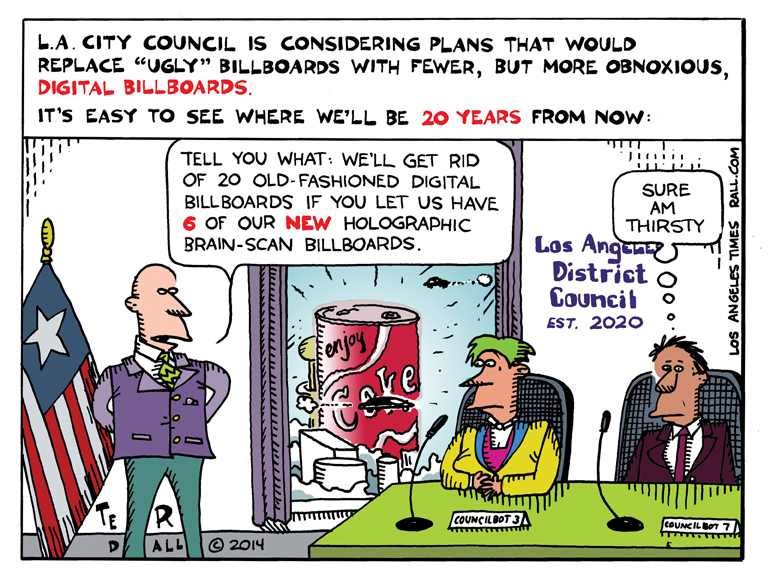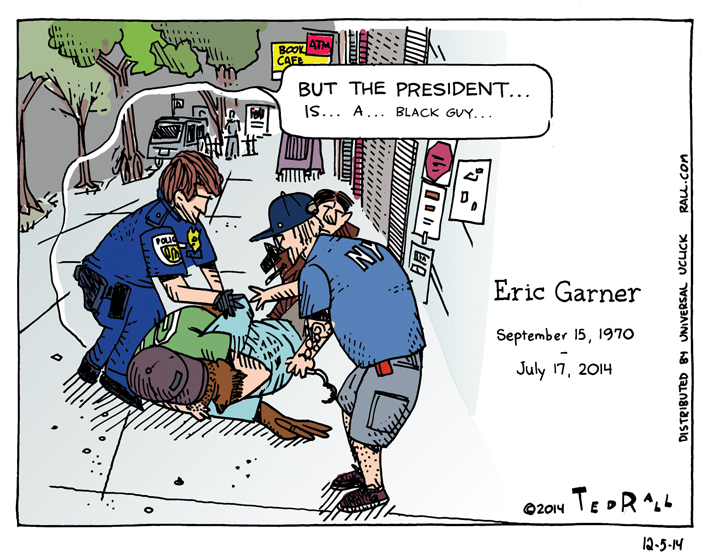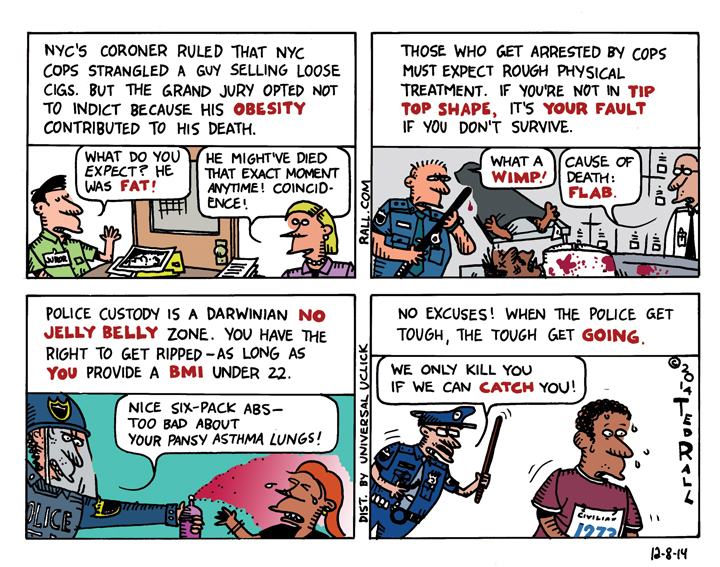LOS ANGELES TIMES CARTOON: The Los Angeles Billboard Wars Continue
Originally published by The Los Angeles Times:
Constitutionally-protected free speech essential to commerce? Hyper commercialistic eyesores and driving distractions? The Los Angeles billboard wars continue.
After digital billboards, what comes next?
For a hot second it looked as though Los Angeles’ ban on digital billboards – essentially giant televisions mounted on top and on the sides of buildings – had settled the matter. But a superior court judge struck down the ban as a violation of free speech under the state Constitution in October, kicking the issue back to the City Council. That rarely bodes well for a coherent solution anytime soon.
That said, there are a number of remedies to what critics describe as a blight of giant moving images reminiscent of the dystopian film “Blade Runner,” which incidentally was set in an L.A. that seemed to have crashed into Hong Kong during endless rain.
Among the possible solutions now being considered by council members are “sign districts,” outside of which digital billboards would be prohibited. However, the idea that seems to have the most traction at this point is to allow a certain square footage of new digital billboards in exchange for the removal of an equivalent, or greater, area of traditional static ones.
David Zahniser reports in The Times: “Clear Channel Outdoor said it favors a takedown formula that allows for new digital billboards. But it has been resisting the effort to scale back the locations where billboards could be permitted. If city officials are interested in eliminating a significant number of older billboards, said company spokeswoman Fiona Hutton, they will need to offer more potential sites for new digital signs.”
No one seems to be proposing an outright ban.
Since nothing in life is certain but death, taxes and advertising in increasingly – and annoyingly – previously off-limits public spaces, the future of digital billboards seems assured in Los Angeles. The only question is, how many will there be and how many of the old-fashioned ones will get taken down.
As a cartoonist who likes to consider possible future ramifications for public policy, I can’t help wonder about what comes next. America’s best minds don’t go into the arts or politics; they work for transnational corporations that hire other great minds on Madison Avenue to figure out how to sell us stuff that we didn’t even know existed, much less needed. Sooner rather than later, therefore, today’s wild and crazy digital billboards will become part of the scenery. Pedestrians, if they still exist, and motorists will learn to ignore them.
After digital billboards, what comes next?
There will have to be something new, and that something probably will include holographic projections that tower over the skyline. Ideally – in their thinking — companies would be able to transmit signals directly into our brains suggesting that we purchase their products. And when that happens, we will go through this process again, taking down ineffectual old digital billboards while issuing the right to fill the skies and clutter our minds.
The Entire Right-Wing Establishment (Including the Democrats) Owes Me an Apology
Now that the Senate report on CIA torture is out, it’s clear that it confirms many of the assertions and reports that I and other dissidents made since 2001. At the time, however, and well into the Obama era, those of us on the left — there were very few of us, since Democrats including Obama continued to support torture and coddling of torturers — who beat the drum about torture and “enhanced interrogation techniques” were smeared as un-American, liars, terrorist sympathizers and pussies.
I was, and continue to be, blackballed by many print and online publications as a result. “Radioactive,” one editor-friend called me — because I oppose(d) torture by Bush and then Obama.
Now people like Richard Engel on MSNBC are saying that “America lost its way after 9/11.” Well, fuck that.
I never lost my fucking way. And I’m still paying a price for it.
Here are some examples of the work that I did back then, which was right, and was widely suppressed:
The Condom Broke. Now What?
The condom broke. Now what? http://www.breakingmodern.com/ted-rall-protection-fails/ @BreakingModern
Got Pokemon Cards?
Got a stash of Pokemon cards you no longer care about? Someone I know would love to have them. If you’re willing to drop them in the mail to me, I’ll send you a signed sketch. (Offer valid only for substantial numbers of cards…not, let’s say, fewer than 10.
Drop me a line by clicking Contact on the menu bar if you’re interested.
SYNDICATED COLUMN: Wimpy Cops and Scared Soldiers: Why Are Americans Such Cowards?
America has a problem that afflicts both her foreign policy and domestic affairs: cowardice.A nation of wusses. That’s us.
That’s not how we see ourselves, of course. Whatever our flaws – impetuousness, naïveté, our sense of exceptionalism – few Americans count pusillanimity among them. For conservatives bravery as a national trait is a given; if anything, progressives wish we’d walk it back a bit, toning down the testosterone in favor of a little humility.
From the outside, however, we look like a nation happy to inflict all manner of mayhem on people all over the world, yet unwilling to put our own precious skins in the game.
Drones are the ultimate manifestation of America’s newfound risk aversion. After more than 12 years of remote-controlled aerial killer robot warfare, the statistics are undeniable: unmanned aerial vehicles are a ridiculously sloppy assassination method that kills anywhere from 28 to 49 times more innocent civilians than targeted alleged terrorists. With the myth of accuracy thoroughly debunked, drones remain popular with the public for one reason: they don’t expose American soldiers to return fire.
What we see as an advantage, however, sparks contempt among foreigners that our adversaries in this war for hearts and minds exploit in their recruitment and fundraising efforts. You see it in the faces of the Afghans and Pakistanis I have interviewed: if the United States military had any honor, they say, it would come and face our warriors man to man, on the battlefield, rather than pushing a button thousands of miles away. Every “terrorist” we blow up makes us look worse.
Moreover, cowardice is unproductive on a psychological level.
During the early years of the American occupation of Iraq, British forces (who patrolled the region around Basra) suffered lower casualty rates in the zones under their control than their American counterparts. One reason, according to military psychologists, is that British troops presented themselves as more willing to expose themselves to the Iraqi public and less afraid of being hurt or killed. Whereas US forces wore wrap-around sunglasses and set up checkpoints behind sandbags and blast walls, sometimes identifying themselves only by shooting at approaching cars – which caused confused Iraqis to floor the gas, prompting US forces to kill them – the Brits acted more relaxed, like traffic agents standing right out on the road. Americans covered themselves with Kevlar and automatic rifles; the British wore formfitting uniforms, eschewed helmets and satisfied themselves with sidearms. Sunglasses were banned. The American approach seemed safer, but the opposite was true. It’s easier to shoot at something – the Americans looked like fascist robots – than someone.
For a country that used to pride itself on a certain stoicism, the United States has become a land of whiny little boys and girls.
Oh, how we cried after 9/11. 3000 dead! Those “Wounded Warrior” TV ads asking for donations to support Afghanistan and Iraq war veterans – excuse me, but why am I spending 54% of my federal tax dollars on defense if I also have to donate to a sketchy charity? – use the same melancholy tone and weepy delivery as Sally Struthers’ classic “save the children” messages. Obviously, it sucks to lose your arms and legs, but let’s grow a pair. Fewer than 7,000 Americans got killed invading two countries they had no business in in the first place.
Let’s put those numbers into proper perspective, shall we? The Soviet Union lost 20 million people fighting the Nazis (who invaded them, by the way). France lost 11% of its population during World War I — the equivalent for us would be 34 million Americans. But the Russians or French don’t bitch and moan as much as us.
Speaking of which, Americans have a lot of balls calling Frenchman “surrender monkeys” considering that nearly twice as many French soldiers were killed in in the 1940 Battle of France over six weeks as the United States lost in Vietnam over the course of a decade. Meanwhile, we’re still whining about the 58,000 we lost in – no, invading – Vietnam.
Here at home, we’re infested with wimp cops.
In recent weeks, we have been treated to grand jury testimony in the shootings of two black men, Michael Brown in Ferguson, Missouri, and Eric Garner in Staten Island, New York.
Both killer cops are bruisers — big, muscular guys. Most of all, they are cops. Cops have partners. They have the backing of the state. They carry tasers. They have nightsticks. They go to the police academy, where they train long hours in the art of subduing human beings. And as we well know, they have access to military style hardware and defensive gear.
As these two sniveling wimps tell the tales, however, they were in desperate fear of their lives.
From two guys, both now dead, who were morbidly obese.
Not to mention unarmed.
Ferguson police officer Darren Wilson (6’4″ 210) claimed that Brown (6’4″ 292) terrorized him. “I felt like a five-year-old holding onto Hulk Hogan,” he testified. Brown “had the most intense aggressive face,” he said. “The only way I can describe it, it looks like a demon, that’s how angry he looked.”
The NYPD’s Daniel Pantaleo told a grand jury that, after he got his arm around Garner, he was terrified that the two of them would crash through the thick glass window of a storefront they were leaning against.
Both grand juries declined to indict the cops.
Sure, these were the testimonies of two heavily lawyered defendants following a script that has gotten countless white policeman off the hook for killing unarmed black men in the past. But you still have to ask: aren’t those big “brave” policemen ashamed of themselves? I’m not sure which is worse, pretending to be afraid of an unarmed civilian – in the New York case, the guy wasn’t even resisting arrest – or the possibility that they actually were scared.
There’s nothing wrong with being scared in the face of danger. Bravery, after all, is the act of keeping cool in the face of danger.
In the United States in recent years, however, bravery has been in short supply – even in the face of very little danger at all.
(Ted Rall, syndicated writer and cartoonist, is the author of the new critically-acclaimed book “After We Kill You, We Will Welcome You Back As Honored Guests: Unembedded in Afghanistan.” Subscribe to Ted Rall at Beacon.)
COPYRIGHT 2014 TED RALL, DISTRIBUTED BY CREATORS.COM
My Daily Dot Cartoon
My @TheKernel cartoon today: SCOTUS considers whether online threats are real. http://kernelmag.dailydot.com/issue-sections/weekly-comic/11044/technically-fair-18/
Breaking Modern Cartoon: Stephen Hawking on AI
My cartoon about Stephen Hawking’s grim remark about AI: http://www.breakingmodern.com/ted-rall-stephen-hawking-ai-no/





